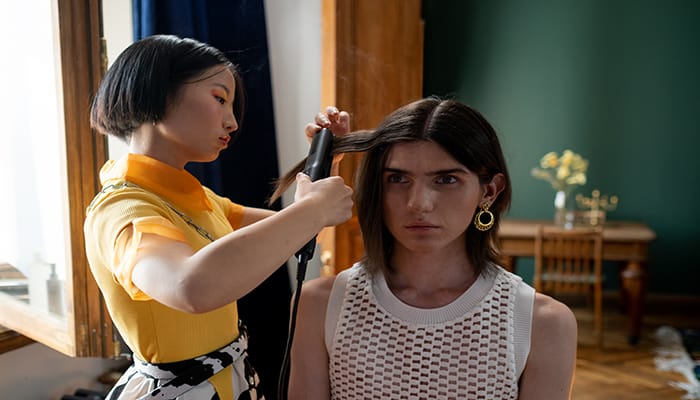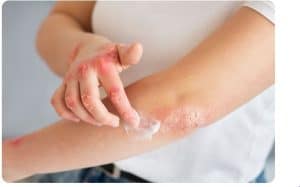
Straightening your hair is a common practice among women, but many may not realize that it comes with hidden health risks. From chemical exposure to physical damage, straightening your hair can have long-term effects on your overall health.
Here are seven of the most significant health concerns of straightening your hair, including hair loss, scalp burns, and cancer. By understanding these risks, you can make informed decisions about your hair care routine and take steps to protect your health while still achieving the desired look.
Table of Contents
1. Cancer
The increased cancer risk is one of the most concerning threats associated with hair straightening. Several studies have suggested that the frequent usage of hair straighteners, particularly by women, may escalate the likelihood of developing uterine cancer.
In recent years, a class action hair straighteners uterine cancer lawsuit has been filed by women who believe that using hair straightening products caused their cancer. According to TorHoerman Law, LLC, the lawsuit alleges that the chemicals in these products, such as formaldehyde, cyclosiloxanes, parabens, and other chemicals, may have caused cancer.
It’s worth noting that TorHoerman Law, LLC has a team of dedicated attorneys that are well-versed in the lawsuit. Thus, having all the necessary information that one may use to build a case for the plaintiff.
While research on the link between hair straightening and uterine cancer is still in its early stages, the results are concerning. Moreover, according to the National Cancer Institute, uterine cancer makes up around 3.4% of all new 65,950 cancer cases. It is the most prevalent disease of the female reproductive system and is, therefore, never to be underestimated.
2. Scalp Irritation
Chemicals used in these treatments can cause irritation and inflammation of the scalp, leading to itching, burning, and redness. It can particularly concern individuals with sensitive skin or underlying scalp conditions, such as psoriasis or eczema.
In addition to chemical irritation, physical damage from straightening tools can also cause scalp irritation. High heat in straightening can burn the scalp, leading to blisters, scarring, and even hair loss. Using straightening tools on wet hair can also damage the hair follicles, leading to scalp inflammation and irritation.
If you experience scalp irritation, seeking medical attention to determine the underlying cause and appropriate treatment is important. It may include topical medications to reduce inflammation or changes to your hair care routine to avoid further irritation.
3. Hair Loss
The high heat and chemicals used in hair can damage the hair follicles, leading to hair breakage, thinning, and even permanent hair loss.
Repeated hair straightening tools can also weaken the hair shaft, making it more prone to breakage and loss. It particularly concerns individuals with already fragile hair or those who have undergone other hair treatments, such as coloring or perming.
Thus, it’s important to limit the use of hair straightening tools and choose products that are gentle on the hair. It’s also recommended to avoid using straightening tools on wet hair, as this can cause more damage.
4. Allergic Reactions
More than 15,000 different compounds, according to the American Academy of Dermatology (AAD), can result in an allergic skin response. Along with this, allergic reactions are potential health risks associated with hair straightening as well. The chemicals used in these products can cause allergic reactions in some individuals, leading to symptoms such as itching, redness, and scalp, face, and neck swelling.
In severe cases, allergic reactions can also cause difficulty breathing, hives, and anaphylaxis, a life-threatening allergic reaction. These reactions can be particularly concerning for individuals with a history of allergies or underlying health conditions, such as asthma.
Thus, it’s important to know the ingredients in hair straightening products and perform a patch test before using them. A patch test involves applying a small amount of the product to a small area of skin, such as the inside of the elbow, and waiting 24 hours to see if any reaction occurs.
5. Respiratory Problems
The fumes and vapors produced by the chemicals used in these treatments can be inhaled, leading to respiratory irritation and potentially more serious respiratory problems.
Certain chemicals used in hair treatments, like formaldehyde, have been associated with respiratory disorders, such as asthma and bronchitis. Prolonged exposure to such chemicals can also heighten the chances of developing respiratory ailments.
The most common is chronic obstructive pulmonary disease (COPD) which, according to the American Lung Association, affects 12.5 million individuals, leading to millions of ER visits and tens of billions in annual healthcare expenses.
Therefore, use hair straightening products in a well-ventilated area and follow the manufacturer’s instructions carefully. Using a mask or respirator to limit exposure to chemical fumes and vapors is also recommended.
6. Hormonal Imbalance
Hormonal imbalance is a lesser-known but potentially significant health risk. Some of the chemicals used in these products, such as phthalates and parabens, have been shown to disrupt the body’s hormonal balance.
The body can suffer from various adverse impacts due to hormonal imbalances, including weight gain, mood fluctuations, and reduced fertility. Moreover, it can heighten the susceptibility to specific types of cancer, such as breast and prostate cancer.
7. Infertility
Infertility is a potential health risk associated with the treatment. In addition, some of the chemicals used in these products, such as phthalates and formaldehyde, have been linked to decreased fertility in both men and women.
Phthalates, in particular, have been shown to disrupt the body’s endocrine system, which regulates hormones that control reproduction. As a result, it can lead to decreased sperm quality in men and reduced fertility in women.
Formaldehyde, another common ingredient in hair straightening products, has also been linked to decreased fertility in women. Again, it is because long-term exposure to formaldehyde can damage the ovaries and reduce the number of viable eggs.
Choose products that are free from phthalates and formaldehyde. Limiting the use of hair straightening tools and opting for natural hair care products instead is also recommended.
Use Straightening Treatments With Caution
While hair straightening treatments may provide a convenient and attractive way to style your hair, they pose potential health risks. These include cancer, scalp irritation, hair loss, allergic reactions, respiratory problems, hormonal imbalance, and infertility.
However, by being informed and taking precautions, you can safely enjoy the benefits of hair straightening without risking your health. Remember, your health and well-being should always be a top priority.
Follow – https://sggreek.com for More Updates


